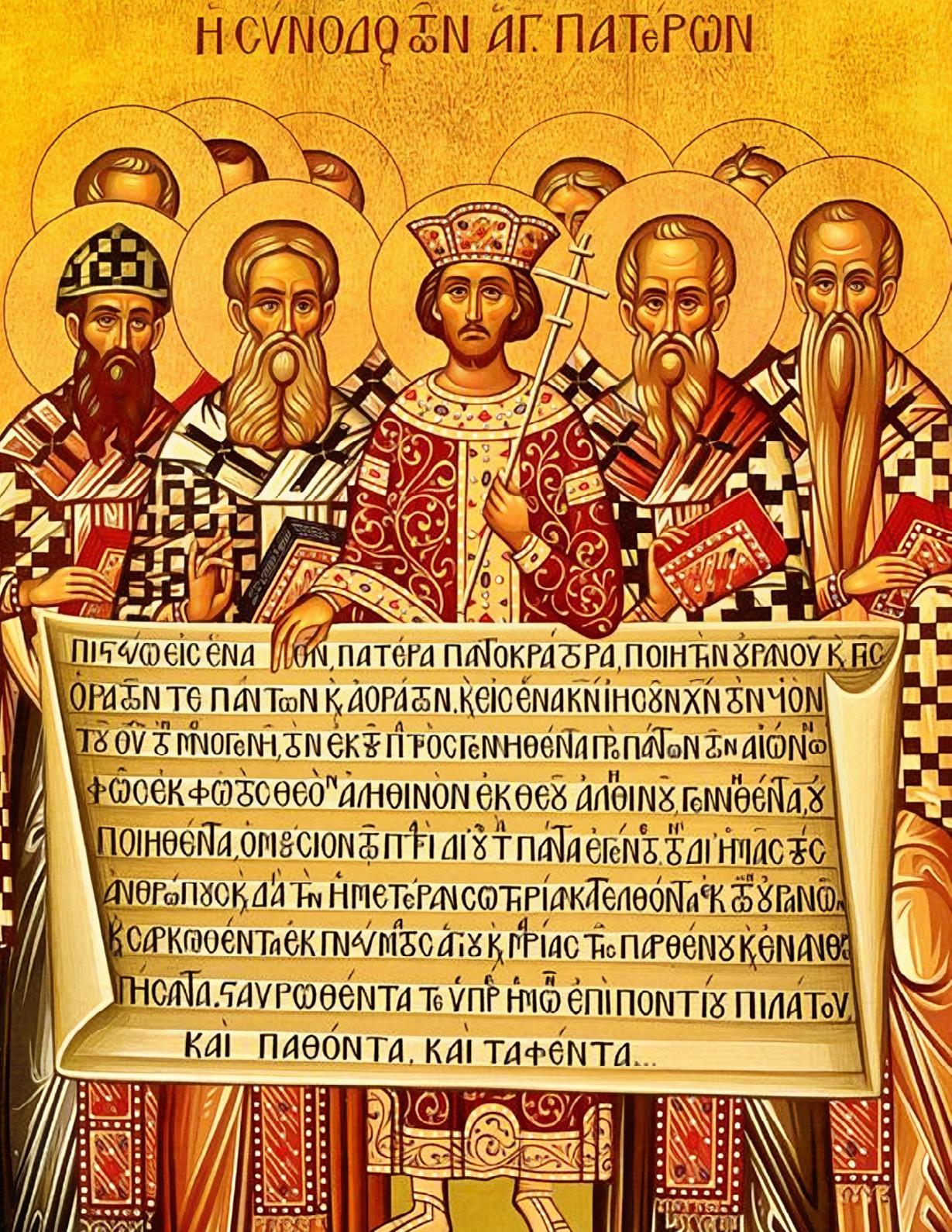

The Nicene Creed
The Ancient Role of the Nicene Creed in Your Christian Faith Words of Truth

Much of American Christianity avoids using creeds in their public worship, just as they often do not even use the Lord’s Prayer. They would make the bold assertion that they hold to the Bible and not to some man-made formula. There is actually an arrogant assertion behind those objections: “Don’t put words in my mouth!” But such a declaration ignores how it is that we humbly learn from the Church of our Lord Jesus which has gone before us.
This year we are observing the 1700th anniversary of the Nicene Creed used by many of us in the service of Holy Communion. True, it is not filled with direct quotations from the Scriptures. Yet these are statements based on clear teachings from the Bible. “The Scripture is God’s voice to us, and the Confession, our reply of assent to it.”
Confessing the truth of what God has revealed to us in His Word has been part of Christian worship from the beginning. The apostle Paul citing the psalmist (116) wrote: “Since we have the same spirit of faith according to what has been written, ‘I believed, and so I spoke’ we also believe, and so we also speak” (2 Cor 4:13). The apostles Peter and John made a similar observation before the condemning Jewish Council: “We cannot but speak of what we have seen and heard” (Acts 4:20).
Paul again captured this natural result between faith in the Word of the God and voiced a creed based on it when he wrote to the Romans: “For with the heart one believes and is justified, and with the mouth one confesses and is saved” (10:19). “Where there is faith, there is also profession of faith. As ‘faith without works is dead,’ so it may be said also that faith without confession is dead.”
The Apostles’ Creed was something that arose organically in the early Christian Church as an elaboration of the baptismal formula Jesus gave us in Matthew 28. But the Nicene Creed, which was given shape by this former creed, arose out of controversy regarding the teachings about the Trinity, especially the person of the Son and the person and work of the Spirit.
Reciting the creeds as we do in our divine services is a high form of praise, since we are acknowledging these statements to be true and beneficial to us. God gives His gifts to us in His Son and we receive them through faith. Just as you are made to feel appreciated when someone does not doubt your word but repeats it to others as true, how much more is God praised for our trust and confession of His saving Word of truth. Luther in his Large Catechism made this observation: “[T]he heart by faith gives God the honor due Him first. Afterward, the lips give Him honor by confession. This is also a blessed and useful habit and very effective against the devil. He is ever around us … he hates to hear God’s name and cannot remain long where it is spoken and called upon from the heart.”
You may not know all the theological arguments and intrigues that went into shaping the expressions of the Nicene Creed, but you can be assured that they are based on the Holy Scriptures given to us by God Himself. By using them, you are expressing what is true and beneficial for you for all eternity. They are words God used His Church from ancient times to put into our mouths today. Thanks be to Him for leading us in our proper worship of Him for these past 1,700 years through this gift of the Nicene Creed!
Question ...
I have questions as to whether I was baptized or not. My parents joined the congregation when I was very young, and for most of my life I just assumed that I was baptized. Yet, as I’ve gotten older, I’ve begun to experience some nagging doubts. I have no baptismal certificate or other evidence that my baptism was ever performed, and I can no longer ask my parents about it because they are deceased.
What should I do?
On life’s stormy seas, Holy Baptism anchors our faith to God’s clear promises in His Word. Uniting us with Christ’s death and resurrection, baptism assures sinners that they are now children of God by grace, that their sins have been forgiven, and that they are now clothed with Christ and heirs of eternal life (Gal 3:26-27; Rom 6:3). Instead of relying on changing feelings and perceptions, we hold fast to God’s baptismal promises, boldly confessing “one baptism for the remission of sins.”
Yet when doubt of a baptism’s validity arises, or when someone questions whether a baptism ever took place, faith can lose its anchor. The assurance baptism can provide disappears. A believer can no longer cling to that external, objective sign of God’s grace in Christ.
In that situation, we want to do everything we can to eliminate those doubts. Unless you were baptized as an older child or an adult, you probably have no memory of your baptism. What other evidence would establish that a baptism took place? Churches generally provide a baptismal certificate, which records the date of the baptism as well as the names of parents and witnesses. If you do not have a baptismal certificate, however, ask the pastor to check the congregation’s official baptismal records to see if your name was recorded there. With a little bit of digging, you may find the baptismal proof you seek. If the church has an official record of your baptism, they will gladly provide you with a new baptismal certificate upon request.
If, however, neither a baptismal certificate nor an official church record exists, you may ask the pastor to baptize you. True, in the Nicene Creed we “acknowledge one baptism for the remission of sins.” One baptism is all anyone needs. “There is one Lord, one faith, one baptism” (Eph 4:5). And God is faithful. The promises He makes to us in our baptisms remain valid and certain, even if we would fall away and then later repent and return to the Lord. This is why, under normal circumstances, a Christian would not seek a second baptism.
These circumstances, however, are not normal. In light of persistent, nagging doubts, when you request a baptism, you are really asking the church to see you as someone who has never been baptized. Then, when you are baptized—even if there’s a tiny chance it’s for the second time, this baptism will be your only baptism. In this way, you can remember your baptism, and it will anchor your faith to God’s promises, that “You were washed, you were sanctified, you were justified in the name of our Lord Jesus Christ and by the Spirit of our God” (1 Cor 6:11). On the stormy seas of this life, cling to this anchor always.
Do you have a question for Pastor Van Kampen? ?
Send them via email: Send them via “snail mail”: pvankampen@holycrossmadison.org
Pastor Piet Van Kampen
Holy Cross Lutheran Church 734 Holy Cross Way, Madison, WI 53704

The theme for this issue: “The Nicene Creed”
by PASTOR JAMES BRAUN, Editor, The
As we celebrate the Lord’s Supper weekly at Trinity Lutheran Church, we use the Nicene Creed every Sunday. When we confess the holy, Christian faith with those words, my mind is transported back 40 years. At the phrase, “And became Man and was crucified also for us under Pontius Pilate,” I bow with my head nearly touching the altar and I actually am reminded of a certain choir piece from the 1984 Bethany Lutheran College Choir under the direction of Pastor James Krikava. It’s a musical setting of this creed by Alexander Gretchaninov. A truly marvelous work.
When reaching that point of the Creed, the choir proper singing behind the soloist began to sing a single tone and then proceeded to sing in a way that indicated something different was taking place. What was it? It was the incarnation and the humiliation of Jesus Christ, the news of which causes the Church even today to wonder at its mystery. (The unbelieving world, too, unwittingly recognizes this event; but more on that as we get closer to Christmas.)
And so I bow until we confess the resurrection and ascension, the beginning of our Lord’s exaltation. It’s a visual representation of the respect and honor we have for the Word that became flesh for us and who took upon Himself the world’s sins, and each week I still hear that single tone in my head that moves me to do as I do.
Whether any of you bow or don’t isn’t the point. It’s recognizing that this creed is a clear declaration of the nature of the Holy Trinity and its work, and it’s a confession which has caused many, many to be persecuted and even martyred. For example, on Palm Sunday, 2017, two separate Coptic Christian churches were attacked by radical
The Seventh Annual Apologetics and Worldview Conference
UNSURPASSED CHRISTIAN APOLOGISTS
June 18–19, 2025
Bethany Lutheran College, Mankato, Minnesota
Registration: apologeticscenter.org/events/ Questions? apologetics@blc.edu
Livestreamed? Yes.
Islamists and many were murdered. Soon after, the survivors went out into the streets and chanted the Nicene Creed to show their defiance in the face of persecution, and – more importantly – to confess their faith in the Triune God for their salvation even in the face of violent death. (link below *)
And this is just how it should be. The Nicene Creed puts a large target on the backs of those who confess it. In unreservedly declares the divinity of the Son of God, Jesus Christ. Few churches, even those who claim to be Christian, confess this creed perhaps because they don’t understand it or they do not see the need for statements of belief like this.
Regardless, we both treasure and use the Nicene Creed as the Christian Church has for these past 1,700 years because, well, it simply and clearly tells the truth.
Notes:
The side of the album I’m talking about can be found at the address below. The Creed is the second cut: https://archives.blc.edu/islandora/object/BLCrepository%3A5038
The link to the other side of the album can be found here. Each side can be downloaded: https://archives.blc.edu/islandora/object/BLCrepository%3A5037
* https://www.christianpost.com/news/egypts-copts-chant-nicenecreed-after-palm-sunday-bombings-standing-strong-despite-massacre.html
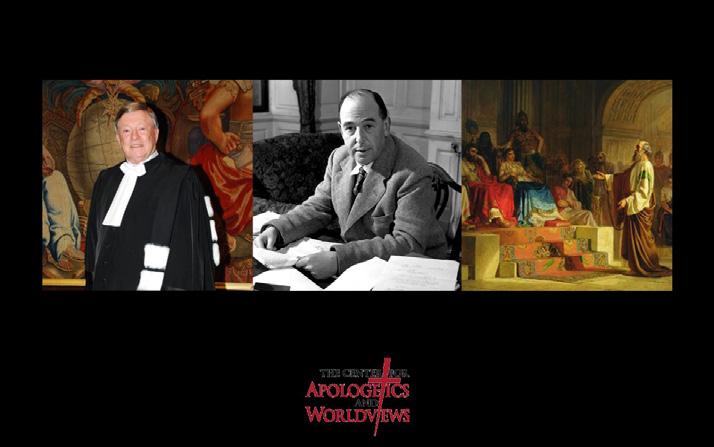
* Presentation periods include time for Q & A and sufficient breaks including over an hour for lunch.
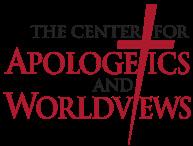
Early Church Apologists & Beyond
PRESENTING EVIDENCE CRITIQUING WORLDVIEWS FORTIFYING BELIEVERS ENGAGING UNBELIEVERS www.apologeticscenter.org
John Warwick Montgomery (1931 - 2024)
C.S. Lewis (1898 - 1963)
THE LEGACY OF:
Lutheran Sentinel Trinity Lutheran Church, Brewster, Massachusetts

The Nicene Creed
by PASTOR THOMAS RANK Professor of Religion, Bethany Lutheran College Chairman, ELS Doctrine Committee
When Jesus came into the region of Caesarea Philippi, He asked His disciples, “Who do men say that I, the Son of Man, am?” So they said, “Some say John the Baptist, some Elijah, and others Jeremiah or one of the prophets.” He said to them, “But who do you say that I am?” Simon Peter answered and said, “You are the Christ, the Son of the living God”. (Matthew 16:13-16)
Does it matter how you define who Jesus is? It matters to Jesus. During His public ministry on earth, Jesus desired those who followed Him to know and believe who He was. He was true God, and true Man. He was the “I Am,” before Abraham (John 8:58). He was the eternal Word (John 1:1) who became flesh (John 1:14).
In the years following Jesus’ ascension, the early church dealt with several attempts to redefine Him. Maybe the man Jesus was empowered by God to be His Son when the Spirit
THE CONFESSION OF CHRIST IS SERIOUS BUSINESS
descended on Him at His baptism. Maybe He existed from eternity but was equal to God the Father. Maybe He is just one of three different ‘modes’ God can choose, not a distinct Person of God. These ideas about Jesus swirled around the early church.
Theologians in those centuries struggled to combat the various false teachings about Jesus. A man named Arius, attempting to defend the truth of only one God did so by diminishing the divinity of the Son to such an extent that the Son was defined as created by the Father. Yes, He had great authority and power, but not equally divine with the Father. This teaching found widespread acceptance in some parts of the Mediterranean world of the late third and early fourth centuries.
The struggle to define Jesus as He was revealed in the Holy Scriptures coincided with the attempts of some Roman emperors to extinguish the Christian faith due to their perception that it could lead to insurrection and revolt against the Roman
ROMAN EMPEROR, CONSTANTINE
Empire. Their solution was to force all people of the empire to worship the emperor, while those who refused would be persecuted. Some of the persecutions were particularly severe. The persecution by Emperor Diocletian (AD 303–313), also known as the Great Persecution, was the last and most severe of these and it left many Christian leaders with lasting scars.
When a new emperor (Constantine, AD 272-337) began his rule, he desired to protect Christianity within the Roman Empire and also to bring unity within the church on a variety of issues, including the debates over who Jesus truly is, as defined and revealed in God’s Word. To this end, He called for a meeting of leaders of the Christian Church to be held at the town of Nicaea, about 40 miles southwest of the capital of the empire at Constantinople.
The teaching of Arius, summarized with the phrase “there was a time when he was not” in reference to God the Son, provoked a strong response from theologians, especially Alexander, bishop of Alexanderia, and his deacon, Athanasius. They claimed that the teaching of Arius was false, that it rejected the divinity of Son of God (not eternal, not equal to the Father), and undermined the very certainty of salvation by calling into question the sufficiency of the atoning death of Jesus (see questions 149 and 150 in the ELS Explanation to the Small Catechism).
In May of 325, over 300 bishops gathered at Nicaea for this council. Included among the bishops who gathered there were those who bore the marks of the persecution of the Christian faith in the previous years. Some of these men were crippled and blinded when they refused to compromise their faith in Jesus. Now they gathered at this council, limping and half-blind, to join in the making of a confession that has lasted to our own day: the Nicene Creed. Consider the costs these men paid to confess Christ the next time you join in speaking the Nicene Creed at your congregation!
One phrase in particular stands out in the Creed as the Biblical solution to the question of whether or not the Son of God was created by the Father (and therefore not truly divine): “…Light from Light, true God from true God, begotten not created, of the same essence as the Father [homoousion] through whom all things came into being….” Some were content to confess that the Son was “like” the substance or essence of the Father. However, the majority considered the term “like” to be a denial of the divinity of the Son, making Him a different, less than divine, being when compared to the Father. They insisted on confessing that the Son is (and must be) the same essence or substance as the Father. The Son is equally divine, equally eternal, not created. This phrase makes the confession of who Jesus is more precise in the face of compromising language and is what has been handed down to us seventeen centuries later.
The question, “Who is Jesus?” has not gone away, and will not go away until He comes in His glory and power on the Last Day. Until then, the Christian Church is called upon to confess just who Jesus Christ is, even though this confession of the Christian faith comes with consequences. Confessions of faith are often made with the blood of martyrdom, the blood of persecution. Our confession dare not become haphazard, trite, or compromised in any way.
Our Lord asks our generation the question He asked of His disciples: “Who do you say that I am?” Are we content with shallow and equivocal statements? Or are we prepared to confess the full truth of Jesus as true God, begotten from eternity, and true Man, born of the Virgin Mary? Pray that God blesses us with continued boldness in the face of pressure to conform the faith to the desires of the world and its agenda. Confession of Christ is serious business. It is about forgiveness of sins, salvation, and eternal life. It is what we desire to proclaim and confess, for ourselves, for our families, for this world.
Lord Jesus Christ, with us abide, For round us falls the eventide; Nor let Thy Word, that heav’nly light, For us be ever veiled in night.
In these last days of sore distress Grant us, dear Lord, true steadfastness. That pure we keep, till life is spent, Thy holy Word and Sacrament.
(ELH 511:1,2)

The Nicene Creed
The Creeds in Mission
A home mission is a “new congregation.” Everything feels new when people are first coming to worship in a temporary setting, as they did when our congregation held its services on the patio of the parsonage from 2013 to 2018. Everything still feels new when the church building is dedicated, which for us was in April of 2018. Even as individuals or families join the mission congregation, for them it is a new congregation.
by PASTOR THOMAS RANK
Associate Professor of Religion, Bethany Lutheran College
But in a very real sense, it is not new. Even if a congregation only has a smattering of people worshipping, it is not small. The mission congregation is part of the “one holy Christian and Apostolic Church.” It’s old, and it’s huge: “a great multitude which no one could number, of all nations, tribes, peoples, and tongues” (Rev 7:9). The mission church is part of Christ’s church on earth that is connected to His church in heaven. This church is as old as the apostles in the New Testament era, and as old as Adam and Eve, Abel, and Seth in the Old Testament era.
In the Evangelical Lutheran Synod, our mission congregation is blessed to be connected to a strong tradition of using the liturgy that dates back more than 1,500 years and connects us to Christians of all times and places. One of the oldest things given to us to use in the church service are the creeds. The Apostles’ Creed is probably more than 1,900 years old, and the Nicene Creed is 1,700 years old this year.
The Nicene Creed answers a question that is particularly important in reaching out to people who need to know Christ. It answers the question: “Who is Christ?”
The Nicene Creed was formulated because of Arius’ false teaching which said that the Son of God was not eternal; that there is a time when His existence began. Whereas the Bible teaches that He has no beginning: “He was in the beginning with God. All things were made through Him” (John 1:2-3). “God’s own purpose and grace was given to us in Christ Jesus before time began” (2 Tim 1:9). Even though Arius taught that Christ was above the rest of the creation, that He was a unique creation, this means that Christ was to be considered a creation of God, actually a created being, “made” by God the Father along with other created beings. Thus, the Son would be inferior to the Father in His nature as God, which is false.
People who listen to this false teaching – and there are many, adherents of the Mormon religion chief among them – are confused about who Christ is. If Jesus is not true God from eternity, this false teaching would make it impossible for Him actually to be the Savior.
The Nicene Creed provides a clear teaching about who the Christ is. It says He is “one substance with the Father,” which tells us that He and the Father are one (John 10:30), and that the Persons of
by PASTOR JERRY GERNANDER Hope Lutheran Church, Leander Texas
the Trinity are equal in glory, power, and are uncreated and eternal. The Nicene Creed says that Christ is “begotten of His Father. Before all worlds.” It says He is “not made.” It says that He “came down from heaven” for every human – “for us men and for our salvation.” It says He “was made man.”
Our mission congregation uses the traditional wording of the Nicene Creed that we have used in the Evangelical Lutheran Synod since English began to be used. The mission church and the established congregations are thus united and “speak the same things” (1 Cor 1:10). The wording does not need to be changed just because the church is a mission; these words in the Nicene Creed are above cultural differences. They unite people of different locations and vocations.
It also helps with evangelistic efforts, both in congregationally sponsored outreach and in personal witnessing on a daily basis in our vocations. This creed provides a clear, uniform way to communicate the Gospel to newcomers or to people in our communities.
If members of the church are not sure what to say to someone about Jesus, the Nicene Creed makes it easy. It gives an outline. It gives the answers to: Who is God? Who made the world? Did He make the angels too? Who is Christ? What did He do? Whom did He do it for? What about the Holy Spirit; where does He come from? (“He proceeds from the Father and the Son.”) Is this life all there is? (“I believe in the resurrection of the body and the life of the world to come.”) Baptism and the remission of sins even have a place in this creed, which can be utilized in conversations with people we meet.
It is important for us who say the Nicene Creed Sunday after Sunday to know where these statements of the creed come from in the Bible. This year, our congregation has heard sermons on the Nicene Creed during the Easter season, and we will study it in Bible Class over the summer.
Confessing the Nicene Creed also encourages us. We have struggles that are different from the generations of Christians before us and that are different from those who will come after us; yet our faith is one and the same. People who are new to a congregation also can feel that they are not at a disadvantage in “knowing less” than those who have been in the church for a longer period of time.
Confessing the creed together means that we are all saying, “I believe,” confessing the “one faith” (Eph 4:5), speaking “the faith once for all delivered to the saints” (Jude 1:3), and receiving the joy of being united in the one true faith, children and adults together.

The Nicene Creed

Christians gather to worship from Sunday to Sunday. Many of us join in the parade of the saints when we sing texts like:
Glory be to the Father and to the Son and to the Holy Ghost, as it was...
Lord, have mercy, Christ, have mercy...
Glory be to God on high, and on earth, peace goodwill...
Holy, Holy, Holy, Lord God of Sabaoth...
SINGING THE FAITH SINGING THE FAITH
...Blessed
is He who comes in the name of the Lord...
...Hosanna in the highest...
O Christ, the Lamb of God, you take away the sin of the world…
by PROF. DENNIS
These are poems that invite a lyric expression. They are hymns of faith and hope. They are all inspired by, or drawn from, the lyric poetry of the psalms or canticles of Scripture and the poetry of the early church. When we sing these songs, we exercise our roles as a “choir of priests.” We speak to God in thanks and we acknowledge His identity and His attitude towards us, we speak to one another, and we speak to God on behalf of one another. When we sing, the saints who have sung these texts millions of times speak to us and through us.
At first hearing, the Nicene Creed does not seem to be a lyric text. It is a magnificent dogmatic sculpture, hewn from the granite of God’s Word which sets forth the Christian truth in profound and pithy phrases. It invites us to enter into the mystery of God, and confess that mystery with others of the faith. But it is not poetry.
As Christian worship practices developed in the early centuries, the Creed was put alongside songs that were sung in every divine service (mass). It was elevated to a place among the hymns of the liturgy, even if it was not the most lyrical of texts.
Those who composed the old chant melodies did their best to marry it to melodies that would be memorable. A melody has power to place a text in a special part of our brain library. These are words that need to be remembered, so they were given notes. And the words were remembered.
By the time of the Reformation, composers were expected to put the text to music, especially for the “important” services, and for the sake of the students who were singers in the most important choral positions. The people may have sung versions in the vernacular, alongside the Latin presentation of the text which was sung by the priest or the choir. This was frequently the practice in Lutheran churches where the choir would sing the text in Latin, and the congregation would respond, according to the three parts of the Creed, with Luther’s paraphrase (We All Believe in One True God, ELH 38). Luther’s paraphrase reflected the chief ideas of the Nicene Creed, but it was paraphrastic, and could not include all of the nuances of the rich dogma presented by the creed. The full Latin text was sung where a Latin parochial school was the chief means of Lutheran education.
MARZOLF
Bethany Lutheran College, Mankato, Minnesota
THE NICENE CREED
Bach from The Great Mass in B Minor
Bach uses “antique” music for the opening of the Creed. The old chant melody is presented in imitative repetition, perhaps bringing to our mind the repetition of this statement of belief through the ages of Christendom. The melody of that the brief chant, and the strict contrapuntal layering of the different voices, reminds us that there is no salvation aside from this belief, as we confess in the Athanasian Creed.
Credo in unum Deum. I believe in one God.
If this were an opera, or a grand piece of musical theater, the lights and costumes would change at this moment. The antique flavor of the opening act gives way to all of instruments and their various families. Oboes and bassoons and the trumpet and timpani join to make a joyful noise to the Creator of all that is, visible and invisible.
Credo in unum Deum, Patrem omnipotentem, factorum coeli et terrae, visibilium omnium et invisibilium.
I believe in one God, the Father almighty, maker of heaven and earth and of all things visible and invisible.
God and man are one in Christ. The two voices express the diversity and the unity of natures in Jesus.
Et in unum Dominum, Jesum Christum, Filium Dei unigenitum et ex Patre natum ante omnia saecula.
Deum de Deo, lumen de lumine, Deum verum do Deo vero, genitum, non factum, consubstantialem Patri, per quem omnia facta sunt. Qui propter nos homines et propter nostram salutem descendit de coelis.
And in one Lord Jesus Christ, the only-begotten Son of God, begotten of his Father before all worlds. God of God, Light of Light, very God of very God, begotten, not made, being of one substance with the Father, by whom all things were made. Who for us men and for our salvation came down from heaven.
The Nicene Creed was an inspiration for many composers in the Lutheran and Roman confessions, and we know of hundreds (thousands?) of musical settings by composers from 1365 to the present day.
It seems fitting as a part of our commemoration of this creed to spend a few minutes to focus on one of the greatest musical expressions of that text from J.S. Bach’s “Great Mass” in B Minor.
We might wonder why that Lutheran composer would bother with composing a setting of the choral Divine Service (mass) in Latin. Martin Luther was a conservative reformer, and he desired that the reformation of the service did not cause offense to those who had grown accustomed to a form of worship that had shaped their faith. But he was also concerned that the service would be purified so that the
God humbled Himself, taking on flesh in the womb of the Virgin Mary. The descending melodies portray this humiliation in a profound, but astonishingly gentle, lullaby.
Et incarnatus est de Spiritu Sanctu ex Maria virgine et homo factus est.
And was incarnate by the Holy Ghost of the Virgin Mary and was made man.
The Credo has nine musical movements, or sections. “Crucifixus” is the pinnacle of Bach’s musical architecture. The repeating bass line (ground bass) suggests that this is the height of the drama. Perhaps he is attempting to illustrate the suffering of this horrific moment. Perhaps he is reminding us that the pulse of all creation finds meaning and purpose in the death of Jesus Christ. It is the centerpiece of the Creed, and the centerpiece of the Christian faith. It is finished!
Crucifixus etiam pro nobis sub Pontio Pilato, passus et sepultus est.
And was crucified also for us under Pontius Pilate. He suffered and was buried.
J.S.
members of the “new” church could remember that they were really the members of the one, holy, catholic, and apostolic church.
So, the blueprint of the old Romish Divine Service was infused with a new life. The Latin remained, and Johann Sebastian was at home with that language, as he was in his own German. He was also at home with the musical styles and sensibilities which embraced the antiquated as well as that which was at the cutting edge of the contemporary musical style of the 18th century Baroque. Thanks to Luther for that attitude. Love the old, build the new on the best foundations to invite the best thought and expression in service of the Word.
Bach’s Mass, and the Nicene Creed which is a part of it, represents a catalogue of his life’s work, and it includes new music and reimagined works. It is a part of his last will and
testament. Though it had a purpose (titular recognition), it was bigger than that. It is a musical representation of the theology which had shaped his thought and his vocation.
The Great Mass includes the texts of the Kyrie eleison, Gloria in excelsis Deo, Creed, Sanctus (and Benedictus), and Agnus Dei. You already know the words, even if you don’t know the Latin. Don’t let that discourage you! Find a recording of the Credo (there are many; I love this cycle by the Netherlands Bach Society because you can watch the performers. (https:// www.youtube.com/watch?v=3FLbiDrn8IE), and listen with the text in front of you. I will add some notes of encouragement. There are many ways to commemorate the creed, and I am sure that this little exercise will help you to ponder the text. I hope that it will enrich the great truths of Scripture as they are expressed in the Nicene Creed as interpreted by one of Lutheranism’s greatest evangelists.
As we would expect, all the joyful sounds of creation appear again to proclaim the glory of the resurrection, ascension, session at the Right Hand of the Father, and the final revelation of Christ’s glory and His eternal reign.
Et resurrexit tertia die secundum scripturas. Et ascendit in coelum, sedet ad dexteram Dei Patris, et iterum venturus est cum gloria judicare vivos et mortuos, cujus regni non erit finis.
And on the third day he rose again according to the scriptures. And ascended into heaven. And sits at the right hand of the Father. And he shall come again with glory, to judge both the quick and the dead; whose kingdom shall have no end.
The bassoon and oboes lend a pastoral aspect to this solo for bass. Christ is the Shepherd, the Spirit is His staff which comforts, calls, gathers and enlightens.
Et in Spiritum Sanctum, Dominum et vivificantem, qui ex Patre Filioque procedit; qui cum Patre et Filioque procedit; qui cum Patre et Filio simul adoratur et conglorificatur; qui locutus est per Prophetas. Et unam sanctam catholicam et apostolicam ecclesiam.
And I believe in the Holy Ghost, the Lord and Giver of Life, who proceeds from the Father and the Son, who with the Father and the Son together is worshipped and glorified, who spake by the Prophets. And I believe in one Catholic and Apostolic Church.
Bach returns to an antique and austere musical style for this chorus. Again, the impression is that the confessing church is an old church, connected to a living Christ through His words, “Go into all the world!”
Baptism and the Absolution support us through life, and through the hour of our death. Note, especially, the colorful, or chromatic harmonic presentation of the journey through death…
Confiteor unum baptisma in remissionem peccatorum.
I acknowledge one Baptism for the remission of sins.
… to the new life in eternity, for eternity.
Once again, the wind instruments and timpani appear as the manifestation of life in that perfect re-creation. “In yonder home shall never Be silent music’s voice...”
Et exspecto resurrectionem mortuorum et vitam venturi saeculi. Amen.
And I await the resurrection of the dead, and the life of the world to come. Amen.
Chorus
Chorus
Chorus Aria (Bass)

A Cautionary Tale from the American Frontier: The Nicene Creed
Barton Stone and the Nicene Creed

by
In the late 1700s and early 1800s, waves of pioneers crossed the Appalachian Mountains from the Mid-Atlantic states into Kentucky. Not only did they find a frontier sparsely inhabited by European Americans, but they also entered a religious frontier alive with controversy.
In the small Kentucky hamlet named Cane Ridge, just a few miles north of Lexington, Barton W. Stone (1772-1841) served as the pastor of the local Presbyterian church. Born in Maryland, Stone attended the famed “Log College” in Greensboro, North Carolina, which provided formal training for Presbyterian ministers who would serve on the fringes of American civilization. Taught by David Caldwell (1725-1824), Stone mastered the intricacies of Reformed theology. However, he had some qualms.
Studying the Reformed Confessions, especially the West-
minster Confession of Faith, Stone rejected the doctrines of total depravity (that all humans are born sinful) and predestination (that God chooses believers, the “elect,” for salvation). Instead, he believed that humans had the free will to choose to believe in Christ and become Christians. He also had some questions about the nature of the Trinity.
When asked by his examination board if he accepted the Presbyterian confessions, Stone replied, “I do, as far as I see it consistent with the Word of God.” Unlike confessional Lutheran denominations like the Evangelical Lutheran Synod, which require every pastor to accept all doctrines confessed in the Book of Concord, even conservative Presbyterians at that time allowed pastors to take exceptions with their confessions. Therefore, Stone was approved, ordained, and called to serve Cane Ridge Presbyterian Church.
Stone likely would have remained yet another anonymous frontier pastor had it not been for a historically momentous event which would occur at his congregation, the Cane
PASTOR ADAM S. BRASICH
Hope Lutheran Church, West Jordan, Utah
Ridge Revival. In 1801, his congregation hosted a communion service which attracted nearly 20,000 people. As was common, other local Presbyterian pastors helped preach and administer the sacrament. However, unlike other Presbyterian communion services, Baptist and Methodists preachers also assisted. Instead of practicing closed communion, restricting the sacrament to believers of a common fellowship (which was the norm in nearly all American Protestant churches at this time), all Christian believers were invited to receive the Lord’s Supper.
The revival put Stone and Cane Ridge on the map, but it also brought controversy. Not every Presbyterian pastor in the area agreed with Stone. In fact, many in his presbytery (a regional district of churches) were more conservative and confessional. They protested Stone’s open communion policy and his theological exceptions to the Presbyterian confessions, decrying him as a heretic.
In response, Stone formed his own presbytery, the Springfield Presbytery in 1803. Highlighting his independence, Stone held a funeral service for the Westminster Confession of Faith at his church. Stone’s divergence from orthodox Presbyterian theology continued to widen, and so he dissolved his presbytery and reorganized it as “the Christian Church.” He even composed a “Last Will and Testament of the Springfield Presbytery,” in which he wrote, “We will, that this body die, be dissolved, and sink into union with the Body of Christ at large; for there is but one body, and one Spirit, even as we are called in one hope of our calling.” Additionally, Stone wrote that pastors in this anti-denominational denomination would “preach the simple Gospel…without any mixture of philosophy, vain deceit, traditions of men, or the rudiments of the world.” In other words, there would be no creeds.
Unfettered by creeds, confessions, or denominational standards, Stone’s theology grew more radical. Whereas earlier Stone directed his ire at Calvinist notions of predestination and total depravity, he now took aim at the Trinity and the nature of Christ. Stone publicly taught that Jesus is not “the eternal Son of God.” Instead, He is the firstborn of the Father, begotten before time. Jesus is created. He is not equal to God the Father. Rather, He is subordinate, or below, God in status and rank. Theologically astute ears across the United States perked up. They recognized that Stone revived an ancient heresy, Arianism – the heresy which prompted the Nicene Creed, which united Christians of nearly all stripes since AD 325.
Creeds and confessions, like the Nicene Creed, intend to rearticulate biblical truth. They also hope to settle doctrinal controversy. By positively stating truth, they mark the boundaries of the Christian faith. In the 200s and 300s, a theological controversy broke out about the nature of God and, particu-
larly, how Jesus Christ related to God the Father. An Egyptian priest named Arius (c. AD 256-336) taught that Jesus was literally “begotten,” or created, by God the Father. Therefore, he was not the eternal Son of God, because, as Arius infamously said, “there was a time when the Son was not.” Since God the Father created Jesus, He is not equal to God. Instead, even though Jesus is God, He is lower in rank than the Father. The Council of Nicaea condemned this theology. Barton Stone resurrected it.
That might seem like technical theology, something best left to pastors or theologians – but it isn’t. When someone messes with the doctrine of the Trinity or the doctrine of Christ, they mess with salvation, because God the Holy Trinity saves you, and Jesus Christ, the Son of God and the Son of Man, redeemed you from your sins. Jesus was able to redeem you because He is fully God and fully man. In Philippians 2, the Apostle Paul tells the story of your salvation through those two facts about Jesus. Even though Jesus was (and is) God, He “did not count equality with God a thing to be grasped,” or, in other words, held onto for dear life. So, Jesus “made himself nothing, taking the form of a servant, being born in the likeness of men” (Philippians 2:6-7). Jesus, fully God and fully man, “humbled himself by becoming obedient to the point of death, even death on a cross” (Philippians s 2:8).
Jesus was fully man so that He could place Himself underneath God’s holy Law and live it perfectly as a human being. Nevertheless, He was still God, so that His death could pay “for the sins of the whole world” (1 John 2:2). If we diminish Christ’s humanity or His divinity, then we misunderstand the way God, in His mercy, chose to save us. If we do that, then we misunderstand who God is and how He loves us.
Barton Stone rejected the Nicene Creed as a “tradition of man.” He wanted to follow the Bible alone. While that was, at some level, a noble sentiment, it came with a cost. Stone sought to reinvent the wheel, and he revived an ancient heresy. He rejected the Creed, and so He rejected the biblical doctrine that Jesus Christ is the eternal Son of God who became fully man to redeem us from our sins. Stone wanted to liberate himself from the constraints of tradition, but, consequently, he found himself outside of biblical Christianity. Freedom from creeds created the space for Stone to distort Christ.
There is a cautionary tale from American religious history here. Creeds may be man-made, but they also protect our faith. Faithfully rearticulating biblical doctrine in concise language, they focus our faith on our Triune God and the salvation He gives us. Carelessly rejecting creeds can lead to rejecting Christ.

The Nicene Creed
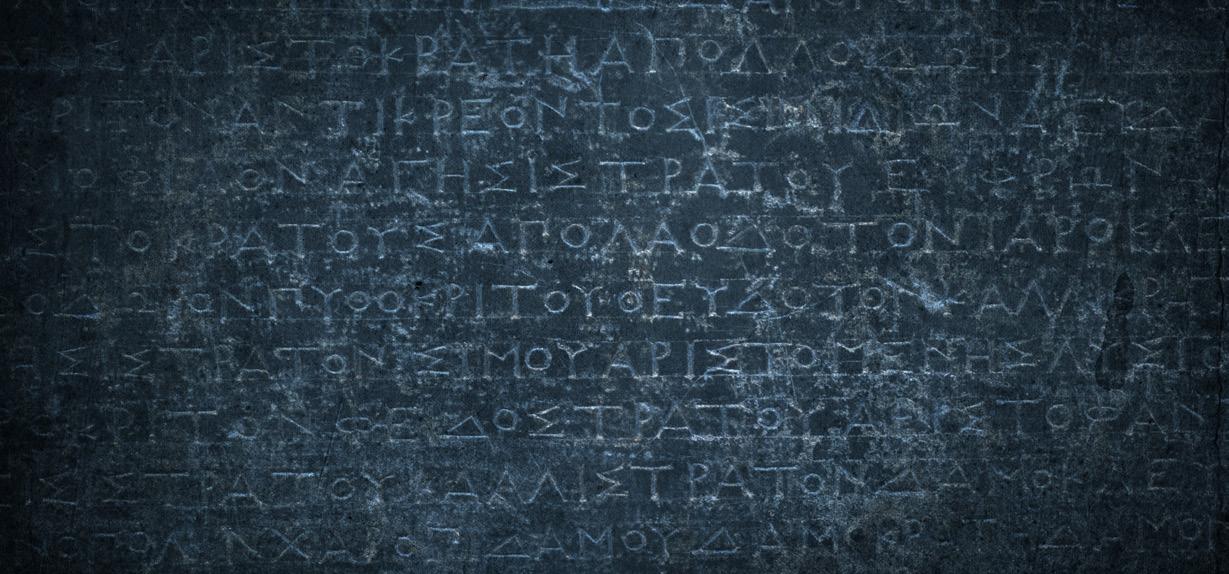
Filioque … and the Son:
The Controversies between the Church of the East and the West
by PASTOR STEVEN SPARLEY
The so-called Filioque controversy is not well known in the churches of the Reformation, including in our Evangelical Lutheran Synod. For example, in Francis Pieper’s Christian Dogmatics, used as the standard dogmatics (doctrine) textbook in the seminaries of the Synodical Conference (including ours), its total of 1689 pages devotes just a single page to the controversy. But it is far different in the Orthodox and Roman Catholic churches, where it lives on to this day.
In reality, there are several controversies involved when it comes to the differences that exist between the Greek-speaking Eastern Church (Orthodox) and the Latin-speaking Western Church (Catholic) regarding the phrase Filioque, which means, “and the Son.” We find the phrase in the Nicene Creed, or more formally, the Niceno-Constantipolitan Creed of 381 A.D., which is commonly used in our regular communion liturgy.
Nicene Christianity as a term is used to distinguish it from the various heresies that arose in the early centuries of the church: Gnosticism, Arianism, Nestorianism. In the west, Nicene Christianity is confessed with the words, “…I believe in the Holy Spirit, the Lord, and Giver of life, who proceeds from the Father and the Son, who with the Father and the Son together is worshiped and glorified …”. In the east, the phrase and the Son is omitted. Because the Eastern and Western
churches have incorporated the Nicene Creed into their liturgies, both of these churches are deeply invested in these controversies.
The same cannot be said of the Apostles’ Creed which is not used in the east. However, in the west it is used in non-communion liturgies and especially in the Rite of Baptism, which is appropriate since this creed arose from early baptismal formulas in the western church. One difference is that it has no specific date or place of origin as does the Nicene Creed.
While the Roman Catholic church long ago ceased to assert that the Apostles’ Creed came from the apostles themselves, it should be noted that the church of the east never offered doctrinal objections to the Apostles’ Creed. They simply assert that the Nicene Creed is the more complete of them and was recognized as the authoritative confession of the Christian faith in the year 381 before there was any division between east and west. Therefore, they assert, it is the creed that united the whole Christian church.
In a very real sense that is true. It should be noted that no reputable western church father objected to the original (Greek) text of the Niceno-Constantipolitan Creed of 381, which was affirmed again at the Council of Chalcedon in 451, a church council which comprised representatives of both the east and the west.
Parkland Lutheran Church & School, Tacoma, Washington
As said above, there is more than one controversy between the eastern church and the western church here. The first controversy is in regard to the legitimacy of the term Filioque. Since the creed was not originally written in Latin, but Greek, the term was of course not used, nor was the Greek equivalent, και Ύιου. It appears that the term Filioque was first inserted into the Latin text of the creed at the Council of Toledo (a city in modern-day Spain) in 589 to clarify the meaning of the creed in the face of the Arian heresy, which asserted that the Christ, the Son of God, was a created being and not “very God of very God.”
However, the thinking behind the phrase Filioque had been vigorously discussed by church fathers over the preceding more than two centuries, including, for example, Cyril of Alexandria (a renowned eastern father) and Augustine (a renowned western father), and many others. However, that debate was never settled by agreement of both the east and the west. And therein lies this part of the controversy between the two.
This brings us to the second controversy, the reactions of the two churches to each other’s statements. The many reactions of the one to the statements of the other were filled with intemperate, if not harsh, language, which included anathemas (condemnations) leveled by the heads of both churches, the Patriarch of Constantinople and the Bishop of Rome (often called the Pope) themselves. That this went on for more than 400 years shows how serious each side considered the matter to be. It was not until 1014 that the Nicene Creed, with Filioque, was first sung in Rome as part of the public Latin liturgy. In these years the Eastern and Western churches were slowly drifting apart, but not only because of the Filioque. The difference in language contributed to the disaffection, as did the use of icons in the Eastern Church, and the insistence in the west that the bishop of Rome had supreme authority over the both parts church.
The third and most important controversy, of course, has to do with the Scriptural nature of the statement Filioque itself. Is it truly Scriptural?
Most of the western fathers defended the use of “and the Son” on the basis of John 15:26-27, John 16:14-15, Galatians 4:6, Philippians 1:19, and 1 Peter 1:11. Most of the fathers of the east did not agree. But their disagreement is not bound up in the phrase “Filioque” only, but also in what precedes it. The Greek original reads, ἐκ τοῦ Πατρὸς
“who proceeds from the Father,” which, due to the particular verb used, does not mean quite the same thing as the Latin a Patre procedentem. That is why Martin Chemnitz, the chief author of the Formula of Concord, wrote:
Both parties confessed that the Spirit is of the Son as well as of the Father; but the Greeks said that He is “from the Father through the Son,” and the Latins said “from the Father and the Son.” They each had reasons for speaking the way they did. Gregory of Nazianzus, on the basis of Romans 11[:36], says that the prepositions ek, dia, and eis express the properties of [the three persons in] one unconfused essence. Therefore, the Greeks said that the Holy Spirit proceeds from (ek, ex) the Father through (dia) the Son, so that the property of each nature [or person] is preserved. Nor did the Latins take offense at this formula for describing the matter. For Jerome and Augustine both say that the Holy Spirit properly and principally proceeds from the Father, and they explain this by saying that the Son in being begotten of the Father receives that which proceeds from the Father, namely, the Holy Spirit; but the Father receives from none, but has everything from Himself. (Loci Theologici, volume 1, p. 143)
A helpful custom in many of the churches of our Evangelical Lutheran Synod is the use of the Athanasian Creed often on Trinity Sunday. See pages 29-30 in our Evangelical Lutheran Hymnary. There is little doubt that this latest of the creeds, which never found its way into the liturgies either of the east or the west, is more properly to be seen as an expanded explanation of the Nicene Creed. I have often said that the Nicene Creed is written in concise, high school level language, while the Athanasian is written in grade school level. It is much longer and yet much simpler, chiefly due to its repetitious style. It is intended to teach the meaning of the Nicene Creed to the ordinary person so that there is no confusion as to what that creed means.
The Athanasian Creed clarifies the theology that underlies the western church’s use of the phrase Filioque in the Nicene Creed and, at the same time, validates in the following words the eastern church’s concerns without delving into the technical matters of Greek and Latin semantics and grammar:
The Father is made of none, neither created, nor begotten. The Son is of the Father alone, not made, nor created, but begotten. The Holy Spirit is of the Father, neither made, nor created, nor begotten, but proceeding.
As we reconsider this centuries old controversy, let us remember that we are responsible primarily for rightly believing, teaching, and confessing pure Scriptural doctrine in regard to the doctrine of the Holy Trinity, while being respectful of, and truthful about, the struggles of those saints who have gone before us. Let us remember also that here we are dealing with the deepest truths of the Scriptures, that is, regarding the persons of the Triune God, Father, Son, and Holy Spirit, as He alone has revealed Himself to us in His holy word.

The Nicene Creed
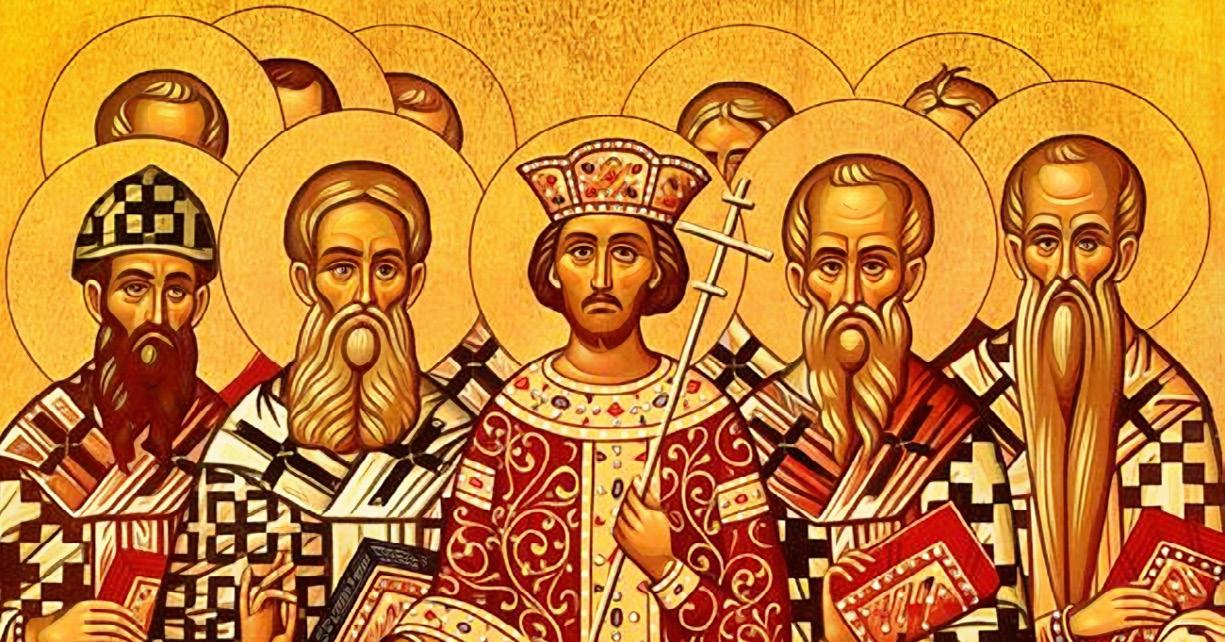
The Council of Nicaea: Myths & History
by PASTOR JACOB KEMPFERT
Gloria Dei Lutheran Church, Saginaw Michigan
I’ve heard it said that “A clear lie often repeated is believed more than the clear truth told once.” That is, even if a statement is demonstrably false, we’re more likely to believe it the more often we hear it. And in this age of misinformation, alternative facts, and artificial “realities,” even outlandish claims with little to no evidence can be repeated without scrutiny or consequence. Sadly, history becomes fertile ground for such repeated lies, and church history is no exception. One example of this in recent years is the prevalence of falsehoods spread regarding the Council of Nicaea.
Convened by Emperor Constantine I in 325 A.D. in the city of Nicaea in Asia Minor, the Council of Nicaea was the first ecumenical council of the whole Christian church and produced the first draft of the Nicene Creed we still recite today. The council’s purpose was to combat the spread of heresy and error in the Christian church.
Everything discussed at Nicaea is publicly available information translated into English that anyone with an internet connection can easily find in a matter of seconds. (For example, see: https://earlychurchtexts.com/public/nicaea_canons.htm)
Yet despite this, myths about what was discussed and decided at Nicaea with absolutely no historical basis or evidentiary
support abound in the public imagination. They have been spread in popular media such as movies, television, and news sites, as well as by social media influencers with little to no formal education, professional training, or practical experience in matters of theology or history.
In honor of the 1700th anniversary of the Council of Nicaea, we’ll take a look at some of the most popular repeated lies regarding the council, so that we can start repeating what is actually true.
Nicaea Myth #1: The Council of Nicaea determined what books would be in the Bible. Those assembled at Nicaea determined the biblical “canon” (from the Greek word meaning measuring rod or rule), and declared which books were the authoritative, divinely inspired Word of God, and which ones weren’t. The powerful leaders of course favored the books that agreed with their opinions and conspiratorially suppressed and destroyed the books that didn’t.
Nicaea Truth #1: The canon was never discussed at Nicaea. The modern myth that the Council of Nicaea determined biblical canon appears to come from the French Enlightenment author Voltaire. Though he seems to be otherwise intelligent,
he nevertheless believed and propagated a fanciful medieval legend about Nicaea: that the biblical canon was determined by placing all the competing books on an altar and canonizing the ones that didn’t fall off. His personal bias blinded him both to historical truth and common sense, preferring instead to believe “irreverent, silly myths” (1 Tim 4:7).
In reality, the Christian church had already discerned an authoritative canon, as documented in earlier lists. A small number of books were still being questioned by some, but this topic was never discussed at Nicaea. Additionally, no doctrine of the Christian faith has ever been drawn from any of the few questioned books - only from those books that have always been recognized as inspired by God. This myth arises from ignorance of history and illiteracy in historical methodology.
Nicaea Myth #2: The Council of Nicaea made Jesus to be God. Before this, Jesus was widely considered a human teacher or prophet with remarkable divine gifts. But in order to consolidate power and exert control over the hearts and minds of others, the Council of Nicaea established that Jesus is God, thereby signifying the pastors and bishops at Nicaea had divine authority over others.
Nicaea Truth #2: Nicaea recognized Jesus as true God, but did not establish a new teaching or revise old teachings. Jesus’ divinity was recognized in His own lifetime and He was already widely known and professed to be God in the immediate years following His ascension. The earliest Gospels (Matthew and Mark) professed Jesus’ divinity. The writings of Paul and Peter also establish Jesus as true God with the same robust and nuanced Christology of the Gospels before the mid 60s, when the two were martyred.
Jesus’ recognition as true God is not a development of doctrine, but a preservation of the established truth in the face of the errors of Arius, who held that Jesus was not equal with the Father but was created by Him. The council did not resolve any theological debate about the Son’s relationship to the Father; rather, it affirmed what the church had already received, believed, taught, and confessed from the beginning. This myth arises from ignorance of theology and biblical illiteracy.
Additionally, in order to revise the “human teacher/prophet” Jesus to be God in order to control the people, Constantine would have had to find all of the New Testament manuscripts around the known world, change them, and then replace them, all without leaving any evidence he did so. A little common sense in these matters goes a long way.
Nicaea Myth #3: Constantine convened this council and forced everyone to agree in order to consolidate his power in the Roman Empire. Similar to pagan Emperors in the past, Constantine abused divine-seeming authority in order to gain political authority, and control his vast and diverse empire.
Nicaea Truth #3: While Constantine convened the council to address heresy and unify church teaching, it’s unclear who actually presided over the council. We have much evidence that Constantine was in attendance, but no evidence that he presided over its proceedings or directed its decisions. Keep in mind that because Constantine was the first Christian emperor, there was no precedent for a Roman Emperor’s presence at a Christian church council. It was a novelty, not a norm. Church historian Eusebius actually tells us that Constantine appeared somewhat uncertain as to what proper protocol was, and deferred to the leadership of the assembled bishops as to when he should stand, sit, and speak (Life of Constantine, book III, chapters X-XIII).
Nicaea Myth #4: The council established the date of Christmas to combat paganism. December 25 was chosen in order to appropriate and sanctify a pagan festival related to the winter solstice.
Nicaea Truth #4: The date of Christmas was never discussed. Rather, the council standardized (but didn’t establish) the date of Easter. This myth seems to tie into a related myth that our current major holidays (Christmas, Easter, Halloween, etc.) were all originally pagan celebrations that were stolen by the Christian church. In reality, according to our best historical evidence, Christmas, Easter, and even Halloween (All Saints’ Eve) were originally Christian holidays unrelated to pagan celebrations.
The Council of Nicaea did discuss the date of Easter, but it did not establish the date for Easter celebrations. Rather, because Christians were already celebrating Easter on different days, the council standardized the date for all Christians to celebrate Christ’s resurrection. The standardized date was selected in relation to the celebration of the Jewish Passover, not in relation to any pagan festival.
A clear lie often repeated is believed more than the clear truth told once. So in the face of repeated ignorance, lies, and deceptions, we repeat the same unchanging Truth. And in the kingdom of Christ who is “the Way and the Truth and the Life” (John 14:6), facts remain always unchanged, for “Jesus Christ is the same yesterday and today and forever. Do not be led away by diverse and strange teachings, for it is good for the heart to be strengthened by grace” (Heb 13:8-9). For “The word of the Lord endures forever” (1 Pet 1:25), and God the Son proclaims, “Heaven and earth will pass away, but My words will not pass away” (Matt 24:35). “And we know that the Son of God has come and has given us understanding, so that we may know Him who is true; and we are in Him who is true, in His Son Jesus Christ. He is the true God and eternal life” (1 John 5:20).
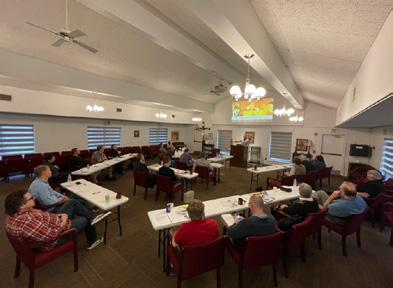

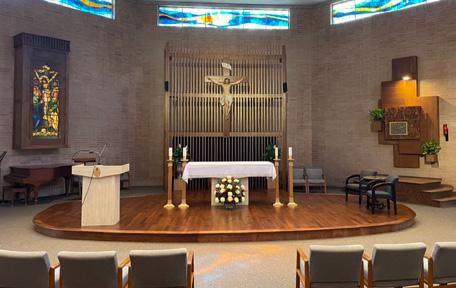
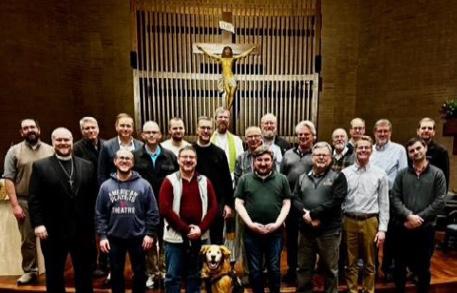
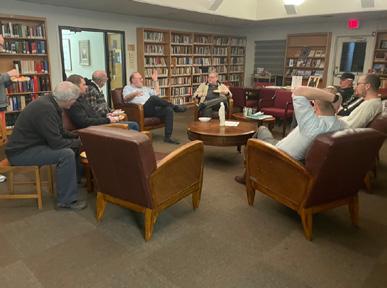
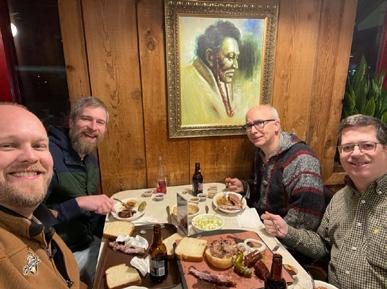
Never Confounded: A Warming Retreat in a Chilly Texas
by PASTOR
In February, the Evangelical Lutheran Synod hosted a pastoral retreat on the theme, “Never Confounded.” At first, I was skeptical because it was more time away from my parish. There are already so many conferences, conventions, and board meetings that it was hard for me to rationalize the time away. I have things to do, sermons to write, and work to do for my congregation. Still, I relented and booked my trip thinking that at least it would be warm in Houston. Upon my arrival, it was anything but warm. It was a balmy 29° most mornings. The water fountain outside my room was usually frozen when I took my morning walks.
Over the course of the week, I found great relief in the warmth and friendship of my brother pastors. It was intimate and the group small, yet the days were busy with sessions that were somewhere between a class and a TED Talk. The topics ranged from Biblical to practical. One thing that stood out to me was that my brothers are in the same boat of struggles as I. Like the disciples on the Sea of Galilee, we all at times panic with stress, overwork, and troubles. Each of us brought our individual problems, thinking they were unique to us; but we found that they were more common than we thought. Most importantly, we were reminded that Jesus was in the boat with us.
Pastor Jerry Gernander, Chaplain Don Moldstad, Pastor Tom Rank, and Dr. Josh Mears led discussions that proved to be both helpful and uplifting. Those assembled shared their own experiences and learned from others serving around the country. The sessions provided an opportunity to strengthen relationships with my fellow clergymen. The time spent in personal gatherings and meals allowed me to grow in my appreciation of those serving the same Lord side by side with me. It was a helpful exercise in putting into practice what I knew to be true.
In the evenings, we gathered in the lobby to share our love of our Savior, discuss our experiences, and get to know a little bit more about each other. Sometimes, at convention, pastors find themselves tending to their delegates. While at the General Pastoral Conference, one will associate and catch up with his closest friends. But this retreat was refreshing in that those walls began to fall. Pastors exchanged outreach tactics that worked, consoled each other in troubles, and prayed for and with each other.
While it may have been freezing outside, there was warmth amongst brothers in our common vocation. Perhaps it was no warmer than during worship. The retreat provided three opportunities to worship each day. Pastor Peter Faugstad took on a hero’s job and preached each service! The worship was different than what I was accustomed to with its lengthy meditation on the Psalms and chanting, but it was a joy to be refreshed in the Word of God and provided a much-needed time for personal reflection. The theme of each service centered around our purpose for this gathering in Texas: Never Confounded. In that small chapel, we rejoiced in the promise of our God, in the fellowship of brothers, and the study of God’s Word.
Houston was cold, but the warmth of the retreat was more than sufficient. As I returned to the seemingly tropical Ohio weather, I had a deeper appreciation for my brothers, tools that helped me work through my struggles in the ministry, God’s Word at my back, and I felt refreshed for another day. While one might wonder if such time away is worth it, this retreat offered more than your standard convention and conference. It provided refreshment in vocation. Thanks be to God!
KURTIS FREIMUTH
Peace Lutheran Church, Deshler, Ohio
SCARVILLE LUTHERAN CHURCH SCARVILLE, IOWA
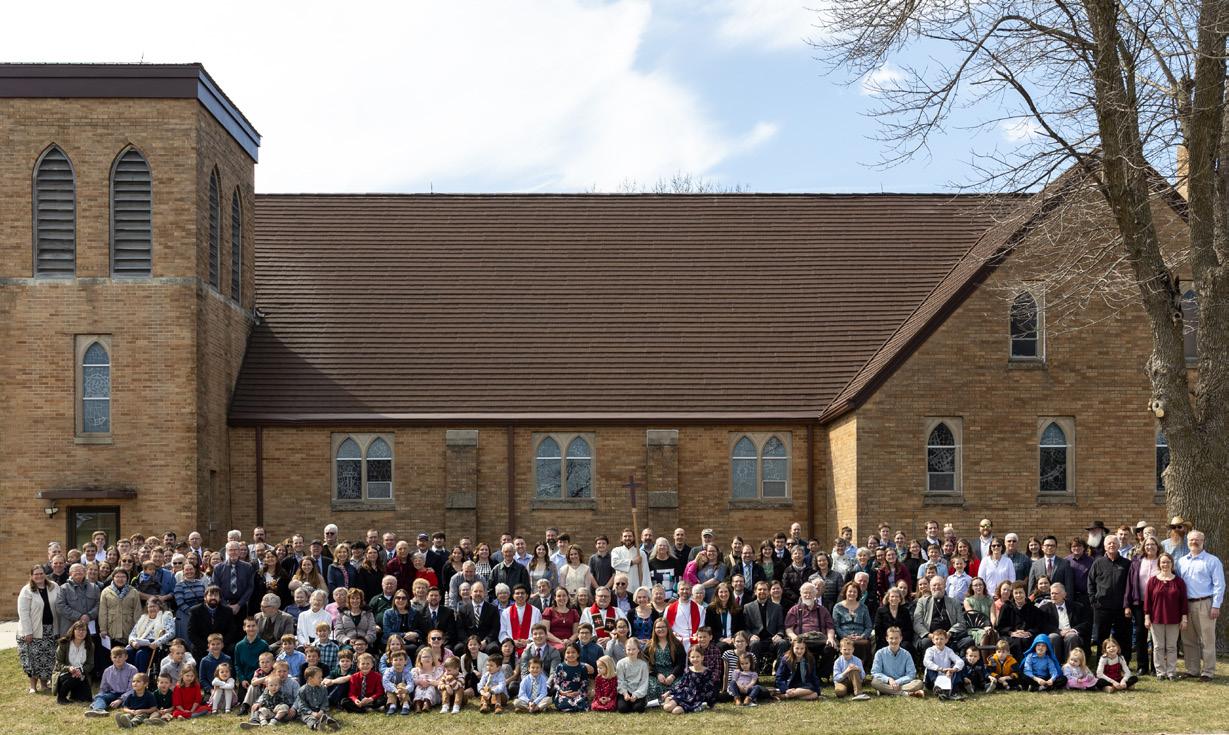
The Scarville Lutheran congregation in Iowa has a new church building. The Evangelical Lutheran Church in America church in town closed its doors in July 2024. (This is the church from which the Scarville Lutheran congregation split on account of the compromise on the doctrine of God’s election of grace in 1917.) This congregation had heard that we were working on getting more space for our K-12 school, and so they originally offered to sell us their building for the school’s use. However, it was becoming evident that it was more fitting for the worship services to be moved to the larger sanctuary. The former members were pleased that their old building would continue to be used for this purpose. They sold us the vintage 1952 building for only $10,000.
A transition committee coordinated the painting, cleaning, and repair work. Hundreds of hours were spent getting the building ready for dedication day. Scarville’s old familiar altar, baptismal font, and pulpit were moved to the new church where they were a perfect fit. Somber, which closed and amalgamated with the Lime Creek and Lake Mills congregations to form Grace Lutheran in Lake Mills, donated their old bell to the church.
April 6, 2025, was the last day of worship at the church building that the congregation had been using since its founding in 1918. That service took place in the morning. After a dinner hosted by the Scarville Ladies’ Aid, the dedication began. The worshipers were blessed with a beautiful
day so that the dedication could begin with a procession from the old church to the new as planned. All were gathered outside in front of the old Scarville Lutheran Church building where they first sang the Doxology in thanksgiving to God for the many years He had blessed the congregation with this house for worship.
The procession then began, led by a processional cross, through the town to the new church. Members carried the chancel furnishings and communion ware. The assembly made their way to the new church building, singing “Ye Lands to the Lord,” “Lift Up Your Heads Ye Mighty Gates,” and “Salvation Unto Us Is Come.” After a picture and the ceremonial opening of the doors, the worshipers entered the sanctuary of the new church for the service.
I officiated the service and dedication. Pastor Peter Faugstad served as lector. Pastor Thomas Rank preached the sermon on Ephesians 2:19-22. Scarville’s adult and youth choir added to the worship. After the conclusion of the service, President Glenn Obenberger addressed the congregation on behalf of the synod.
While the congregation gets adjusted to worshiping in the new building, we rejoice in God’s grace for the building, and more importantly, for what’s inside: the gospel ministry of our crucified and risen Savior.
by PASTOR JOSH SKOGEN
Scarville and Center Lutheran Churches, Iowa
th
ANNIVERSARY
Bethany Lutheran Church Luverne, Minnesota
Sunday August 24 10:15 AM
Bethany Lutheran Church, Luverne, Minnesota, is celebrating her 75th Anniversary on Sunday, August 24 at 10:15 AM. After the service there will be a special meal and sharing of memories. All are invited!
- Pastor Andrew Palmquist

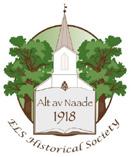
The Twenty-Eighth Annual Meeting of the ELS Historical Society
“The First Decade of ELS Growth”
Presented by Pastor Paul Webber Hymn by the Norseland singers
Sunday, June 15, 2025, 6:30 p.m.
Bethany Lutheran College Lee Theater of the Ylvisaker Fine Arts Center Mankato, Minnesota
A brief business meeting will follow the program. Everyone is welcome to attend.
Call for Articles
If you are interested in submitting an article for consideration to be published in an upcoming issue this year, please send it to the editor’s email at lutheransentineled@gmail.com.
The articles should be between 750-1300 words.
The themes for the last two issues of 2025 are:
September-October: The New Creation
November-December: The Incarnation
